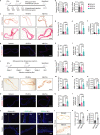Aged bone matrix-derived extracellular vesicles as a messenger for calcification paradox
- PMID: 35304471
- PMCID: PMC8933454
- DOI: 10.1038/s41467-022-29191-x
Aged bone matrix-derived extracellular vesicles as a messenger for calcification paradox
Abstract
Adipocyte differentiation of bone marrow mesenchymal stem/stromal cells (BMSCs) instead of osteoblast formation contributes to age- and menopause-related marrow adiposity and osteoporosis. Vascular calcification often occurs with osteoporosis, a contradictory association called "calcification paradox". Here we show that extracellular vesicles derived from aged bone matrix (AB-EVs) during bone resorption favor BMSC adipogenesis rather than osteogenesis and augment calcification of vascular smooth muscle cells. Intravenous or intramedullary injection of AB-EVs promotes bone-fat imbalance and exacerbates Vitamin D3 (VD3)-induced vascular calcification in young or old mice. Alendronate (ALE), a bone resorption inhibitor, down-regulates AB-EVs release and attenuates aging- and ovariectomy-induced bone-fat imbalance. In the VD3-treated aged mice, ALE suppresses the ovariectomy-induced aggravation of vascular calcification. MiR-483-5p and miR-2861 are enriched in AB-EVs and essential for the AB-EVs-induced bone-fat imbalance and exacerbation of vascular calcification. Our study uncovers the role of AB-EVs as a messenger for calcification paradox by transferring miR-483-5p and miR-2861.
© 2022. The Author(s).
Conflict of interest statement
The authors declare no competing interests.
Figures








Similar articles
-
MicroRNA-183-5p Increases with Age in Bone-Derived Extracellular Vesicles, Suppresses Bone Marrow Stromal (Stem) Cell Proliferation, and Induces Stem Cell Senescence.Tissue Eng Part A. 2017 Nov;23(21-22):1231-1240. doi: 10.1089/ten.TEA.2016.0525. Epub 2017 Apr 28. Tissue Eng Part A. 2017. PMID: 28363268 Free PMC article.
-
Young osteocyte-derived extracellular vesicles facilitate osteogenesis by transferring tropomyosin-1.J Nanobiotechnology. 2024 Apr 25;22(1):208. doi: 10.1186/s12951-024-02367-x. J Nanobiotechnology. 2024. PMID: 38664789 Free PMC article.
-
Extracellular vesicles derived from bone marrow mesenchymal stem cells loaded on magnetic nanoparticles delay the progression of diabetic osteoporosis via delivery of miR-150-5p.Cell Biol Toxicol. 2023 Aug;39(4):1257-1274. doi: 10.1007/s10565-022-09744-y. Epub 2022 Sep 16. Cell Biol Toxicol. 2023. PMID: 36112264 Free PMC article.
-
Brain-derived extracellular vesicles promote bone-fat imbalance in Alzheimer's disease.Int J Biol Sci. 2023 Apr 29;19(8):2409-2427. doi: 10.7150/ijbs.79461. eCollection 2023. Int J Biol Sci. 2023. PMID: 37215980 Free PMC article.
-
Extracellular vesicles in cardiovascular calcification: expanding current paradigms.J Physiol. 2016 Jun 1;594(11):2895-903. doi: 10.1113/JP271338. J Physiol. 2016. PMID: 26824781 Free PMC article. Review.
Cited by
-
Neuroprotective Effect of miR-483-5p Against Cardiac Arrest-Induced Mitochondrial Dysfunction Mediated Through the TNFSF8/AMPK/JNK Signaling Pathway.Cell Mol Neurobiol. 2023 Jul;43(5):2179-2202. doi: 10.1007/s10571-022-01296-3. Epub 2022 Oct 20. Cell Mol Neurobiol. 2023. PMID: 36266523 Free PMC article.
-
Fgf9 regulates bone marrow mesenchymal stem cell fate and bone-fat balance in osteoporosis by PI3K/AKT/Hippo and MEK/ERK signaling.Int J Biol Sci. 2024 Jun 17;20(9):3461-3479. doi: 10.7150/ijbs.94863. eCollection 2024. Int J Biol Sci. 2024. PMID: 38993574 Free PMC article.
-
The role of melatonin in the development of postmenopausal osteoporosis.Front Pharmacol. 2022 Oct 7;13:975181. doi: 10.3389/fphar.2022.975181. eCollection 2022. Front Pharmacol. 2022. PMID: 36278157 Free PMC article. Review.
-
Extracellular Vesicles as Communicators of Senescence in Musculoskeletal Aging.JBMR Plus. 2022 Oct 13;6(11):e10686. doi: 10.1002/jbm4.10686. eCollection 2022 Nov. JBMR Plus. 2022. PMID: 36398109 Free PMC article. Review.
-
Integrated Bioinformatic Analysis of the Shared Molecular Mechanisms Between Osteoporosis and Atherosclerosis.Front Endocrinol (Lausanne). 2022 Jul 22;13:950030. doi: 10.3389/fendo.2022.950030. eCollection 2022. Front Endocrinol (Lausanne). 2022. PMID: 35937806 Free PMC article.
References
-
- Gu W, et al. Role of NFATc1 in the Bone-Vascular Axis Calcification Paradox. J. Cardiovasc Pharm. 2020;75:200–207. - PubMed
Publication types
MeSH terms
Substances
LinkOut - more resources
Full Text Sources
Molecular Biology Databases

